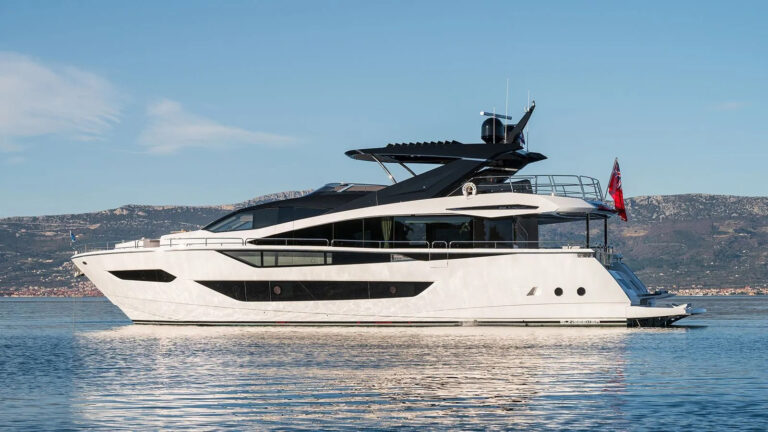These days, a manufacturer has to be awfully clever to capture a piece of the color-screen chart plotter market. Most dealers already stock more than a dozen from different manufacturers. That’s not counting large, multi-function units or any of the small handheld or PDA-based versions. I recently tested the Si-Tex’s new ColorMax Wide chart plotter and found it does a good job of combining cleverness, performance, ease of use and versatility. It should be a strong contender in this market.
The name ColorMax Wide is well chosen, because the 7-inch color display actually is wide. Its 1.6:1 width-to-height, or aspect, ratio resembles that of today’s latest wide-screen televisions. (The company’s other ColorMax models, as well as most standard television screens, have an aspect ratio of 1.33:1.) The unit weighs 21/2 pounds and is 91/2 inches wide, with an internal WAAS-capable GPS receiver.
The worth of a chart plotter is measured first by how well you can read its screen. Here, the ColorMax Wide gets high marks, presenting clear, high-contrast images that are easy to see, even in direct sunlight. The width of the 480-by-234-pixel display came in handy whenever I used the unit’s extensive on-screen menus or displayed depth-sounder information and graphs in a split-screen format. Also, open dialog and data boxes automatically shift to the right or left side of the display, minimizing its interference with chart details.
System control is via seven clearly marked single-function keys, four soft keys arrayed along the lower edge of the display and a miniature joystick. Operations are straightforward enough for you to use the ColorMax Wide first and read its handbook afterward. Be prepared to spend a few hours with the 116-page manual, though, if you plan to use the unit’s full range of navigation options.
Waypoint entry is simple and direct. Each waypoint or mark can be identified by up to eight characters, 16 screen symbols and a choice of seven colors. Your vessel’s track can be displayed in any of the seven colors, as well. When used with care, this display option can help you create an unambiguous chart. Overdoing it, though, may result in color chaos-or modern art.
The “user points menu displays the name and type of all waypoints and marks, along with their latitude, longitude, and the distance and bearing of the selected point relative to the position of your cursor. The list of points is managed via the joystick and four soft keys: View, Find, Delete and Delete All.
Yachtsmen who use the ColorMax Wide in conjunction with radar will particularly appreciate the easy-to-use range and bearing function. Two strokes of the Enter key pull up the appropriate dialog box. Using the joystick, you can create a range circle and bearing line centered on the vessel’s position or on the position of the cursor, identical in appearance to the range and bearing function on the radar. The result: easy coordination with the radar picture.
The plotter, too, is simple to use. The control program tree is well thought-out and easy to navigate. It is built of a 15-item main menu, and 10 items have subsidiary menu options, for a total of 64 selections. Initial set-up is quick, and I had surprisingly little need for referencing the manual.
Once you’ve made your display and function selections, you can manipulate the configuration of your display using the soft keys. When a chart is on screen, the soft keys offer these options: Nav, a comprehensive text and course-deviation display; Road, which provides a road map-based steering aid; Status, which summons current satellite data and Chart, which brings you back to your chart. A nice thing is that the speed of the joystick-controlled cursor can be programmed with separate speeds for working with charts and navigating menus. For working with menus, I found a slow cursor best, and for working with charts, I preferred a quicker cursor.
The ColorMax Wide satisfied my expectations for the speed of its screen redraw, making the chart-zoom function a pleasure to use.
When the boat is under way, Nav mode keeps the vessel centered on the screen, and the chart automatically scrolls as the boat moves. Selecting “screen amplifier from the display menu shifts your vessel’s on-screen position so that the maximum chart area is displayed ahead of the boat, a function similar to the “offset option available on some radar displays.
Chart mode allows for detailed navigational planning, including storage of up to 500 user points and 25 routes of up to 25 points each. You can plot as many as five tracks with up to 1,000 points each at intervals of .01 to 10 nautical miles, or if you’d rather plot by time, one, five, 10, 30 or 60 seconds.
Yachtsmen who cruise in Europe may want to take advantage of an interesting weather forecast subscription service called C-Forecast, developed by C-Map.
C-Forecast provides weather forecasts for a 24-hour period, and the ColorMap Wide can download information for any six-hour chunk within that period. The forecast area is designated automatically based on your boat’s position, heading and cruising speed, a value that is specified during setup. Weather information, including speed and direction of wind, and predicted wave heights, is then superimposed on your chart.
C-Forecast also allows you to receive automatic warnings of dangerous weather conditions based on preset hazard levels for wind velocity and wave height. Forecasts are available for East and West coasts of the United States, the Gulf of Mexico, and Europe south of latitude 65° north (which is mid-Norway, roughly) and east of longitude 15° west. This area includes the Baltic Sea, North Sea, Irish Sea, Mediterranean Sea, English Channel and Bay of Biscay, among other bodies.
C-Forecast subscriptions are available for periods of one to six months at prices ranging from about $35 to $150, or on a per-forecast basis. Prices do not include the cost of the one- or two-minute phone call made from your modem in order to download information. This service requires the ColorMax Wide to be fitted with a cell phone modem specially equipped to operate with Europe’s communication protocol. (In essence, the protocol enables cell phone users to travel internationally using one phone number.) Si-Tex does not provide these modems.
The ColorMax Wide is designed for use on a boat that allows the unit’s built-in GPS receiver to “see the sky, but you can connect a separate, WAAS-capable external GPS sensor if the unit is installed, for instance, in a wheelhouse whose overhead would otherwise prevent the reception of GPS satellite signals. You might also want an external GPS sensor if you plan to mount the unit on a metal instrument panel, which can block reception as well. The plotter can control your boat’s autopilot navigation input, and can be connected to other NMEA 0183 devices, including a depth sounder. The quick-release bracket makes it easy to remove the unit when it is not in use.
One small gripe: My polarized sunglasses interfered with the screen’s readability. I checked again using polarized sunglasses from three different manufacturers and got the same result. I believe a slight change in the angle of the screen’s internal polarizer would help make this already good screen even better.
Many take for granted the information-processing power and memory capacity of today’s marine electronics, but the ColorMax Wide is remarkable in many respects: size, price, range of functions and performance. Price: $2,000. n
Contact: Si-Tex, (727) 576-5734; www.si-tex.com.









